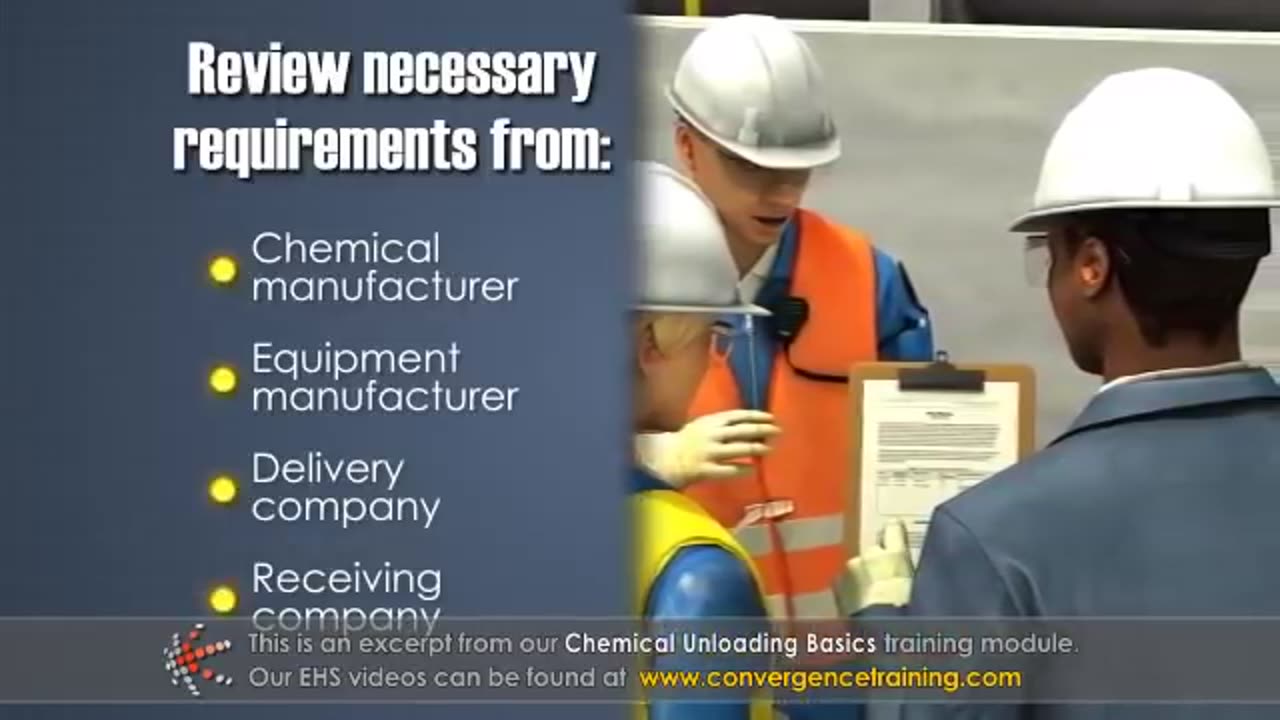Premium Only Content

Chemical Unloading Basics Training
**Chemical Unloading Basics Training** is essential for employees who handle the unloading of hazardous chemicals to ensure safety, prevent accidents, and comply with regulatory standards. Here's an outline of the critical elements typically covered in this training program:
---
### **1. Objectives of the Training**
- To understand the risks associated with chemical unloading.
- To learn proper unloading procedures.
- To recognize and use safety equipment effectively.
- To identify and respond to potential hazards and emergencies.
---
### **2. Who Needs This Training?**
- Warehouse and plant operators.
- Tanker and bulk chemical truck drivers.
- Supervisors overseeing chemical handling processes.
- Maintenance staff working near unloading areas.
---
### **3. Understanding Chemicals and Their Risks**
- **Types of Chemicals Unloaded:**
- Acids, bases, solvents, gases, and other industrial chemicals.
- **Hazards Associated With Chemicals:**
- Flammability, reactivity, corrosivity, and toxicity.
- **Reading Safety Data Sheets (SDS):**
- Information on chemical properties, risks, and handling precautions.
---
### **4. Personal Protective Equipment (PPE)**
- Common PPE used during chemical unloading:
- Chemical-resistant gloves and suits.
- Goggles and face shields.
- Respiratory protection, if necessary.
- Inspection and proper use of PPE to ensure effectiveness.
---
### **5. Equipment and Tools for Chemical Unloading**
- Types of unloading systems:
- Hoses, pumps, valves, and connections.
- Inspection and maintenance of unloading equipment.
- Proper use of grounding and bonding to prevent static discharge.
---
### **6. Step-by-Step Unloading Procedures**
- **Preparation:**
- Verifying permits, documentation, and pre-unloading inspections.
- **Unloading:**
- Connecting equipment securely.
- Monitoring pressure, flow rates, and chemical levels.
- **Post-Unloading:**
- Disconnecting equipment safely.
- Cleaning and securing the unloading area.
---
### **7. Emergency Preparedness and Response**
- Identifying spills, leaks, or other incidents.
- Using spill kits and containment measures.
- Evacuation procedures and emergency shutdown processes.
- Reporting incidents to supervisors and regulatory agencies.
---
### **8. Regulatory Compliance**
- Overview of applicable regulations, such as:
- OSHA's Hazard Communication Standard.
- EPA regulations (e.g., Spill Prevention, Control, and Countermeasure [SPCC]).
- Local or industry-specific requirements.
- Documentation and record-keeping for unloading operations.
---
### **9. Best Practices for Chemical Unloading**
- Maintaining clear communication with all team members.
- Keeping the unloading area clean and organized.
- Regular training updates and drills to reinforce safety practices.
---
### **10. Duration and Certification**
- Training typically lasts 2–6 hours, depending on the depth and complexity of the materials.
- Certification is often provided upon completion, with periodic refresher courses required.
Would you like detailed guidance on a specific unloading process or related safety measures?
-
 20:24
20:24
HSESafetyInformation
8 months agoKABULI PULAO RECIPE - Original 40+ KG Afghani Meat Pulau Prepared - Street Food Qabili Plav Recipe_2
37 -
 21:39
21:39
Nikko Ortiz
3 days agoI Take A North Korean Shooting
44.4K8 -
 LIVE
LIVE
Lofi Girl
3 years agolofi hip hop radio 📚 - beats to relax/study to
185 watching -
 2:14:13
2:14:13
FreshandFit
13 hours agoShe Was Given Extravagant Gifts And STILL Friendzoned Him +EXPOSED
188K36 -
 1:16:07
1:16:07
Man in America
11 hours agoOperation Gladio: The CIA, Mossad & City of London’s Plan for a New World Order
25.5K28 -
 2:11:41
2:11:41
Badlands Media
13 hours agoDEFCON ZERQ Ep. 016: Shadow Governments, Ancient Tech & the Spiritual War for Humanity
81.9K58 -
 2:09:24
2:09:24
Inverted World Live
7 hours agoRats Have Learned to Hunt Bats | Ep. 135
31.2K14 -
 2:48:01
2:48:01
TimcastIRL
8 hours agoLIVE Election Coverage: Polling Stations SWATTED, Bomb Threats Called In | Timcast IRL
254K177 -
 3:30:07
3:30:07
Barry Cunningham
8 hours agoBREAKING NEWS: COUNTDOWN TO COMMUNISM! ELECTION RESULTS SHOW!
59.5K47 -
 2:11:28
2:11:28
DeVory Darkins
7 hours agoLIVE NOW: 2025 Election results and Exit Polls AMA
70K46